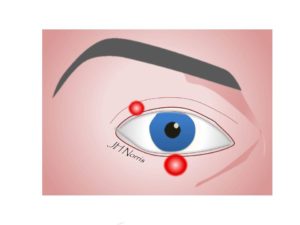Meibomian glands are found within the eyelids and produce the oily component of your tear film. There are over 20 glands on each eyelid.
Chalazia are often found in patients with blepharitis. Debris from the skin accumulates around the base of the eyelashes (similiar to dandruff) and blocks the meibomian glands preventing the oils from reaching the surface of the eye. This can result in cyst formation.
Common symptoms include:
- A raised, red lesion on the eyelid that may sponatenously discharge.
- The lesion may be tender and cause the eyelid to swell.
The medical treatment is the same as for blepharitis with warm eyelid compresses and eyelid hygeine (see blepharitis page). Occasionally we may use an steroid eye ointment and a course of oral antibiotics such as Lymecycline .
Surgical management includes incision and currettage of the cyst. This is usually performed on the back of the eyelid and so usually leaves no scar on the front surface of the eyelid. The surgery is performed in clinic and you are usually able to go home shortly afterwards. You may have a patch on after your procedure and we do not recommend that you drive.
The incision and currettage can result in bruising and blood stained tears for a few hours. Occasionally despite the incision and currettage there may be a residual lump seen on the eyelid.
Author: Mr Jonathan Norris FRCOphth


